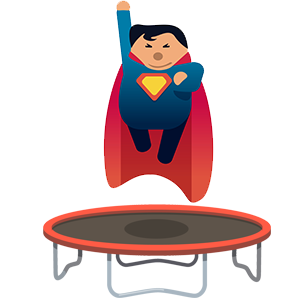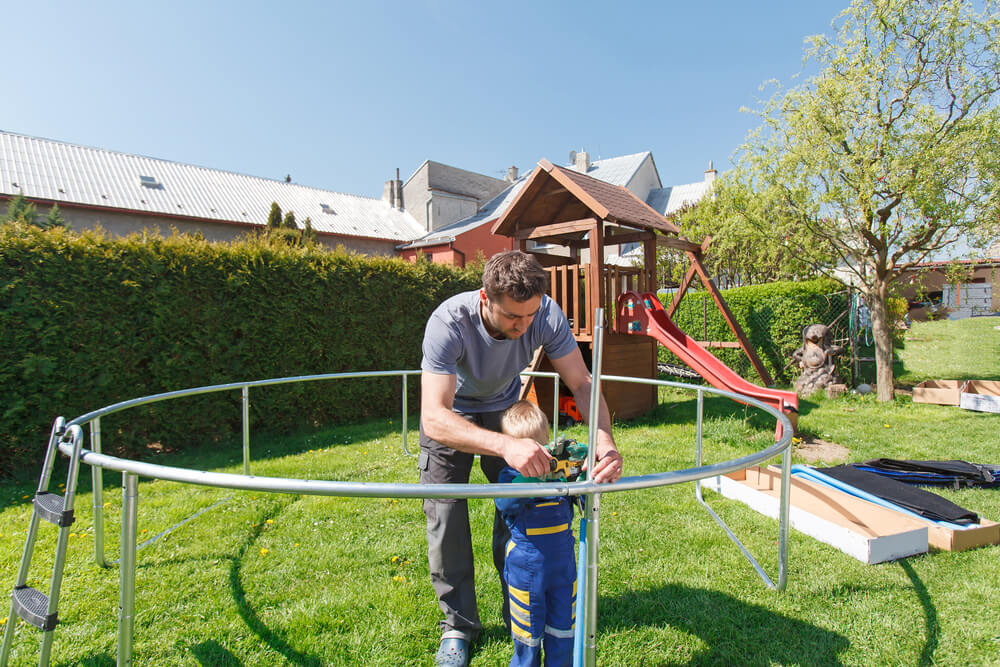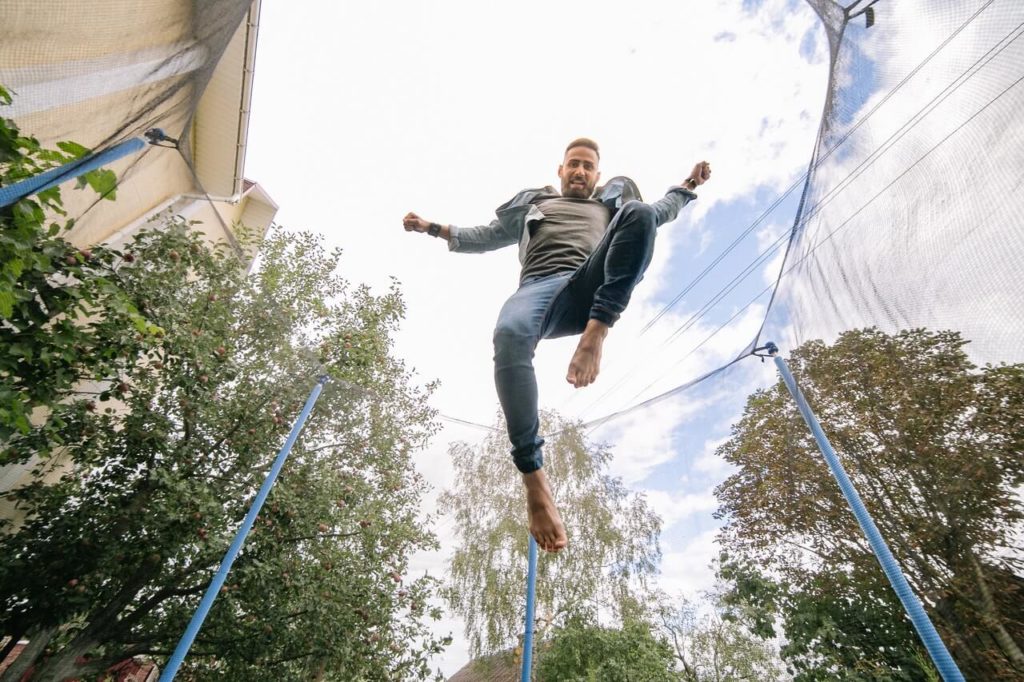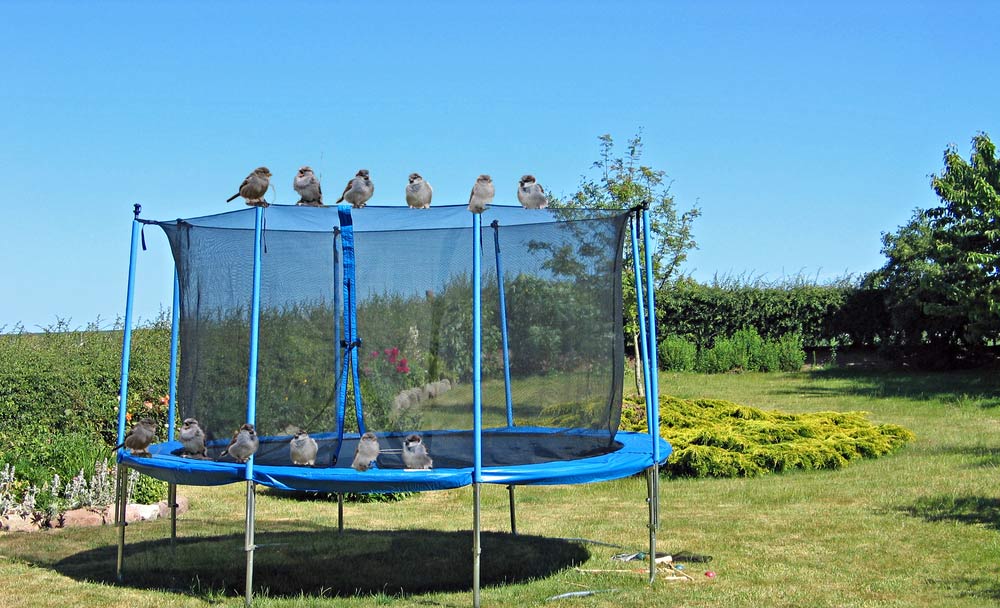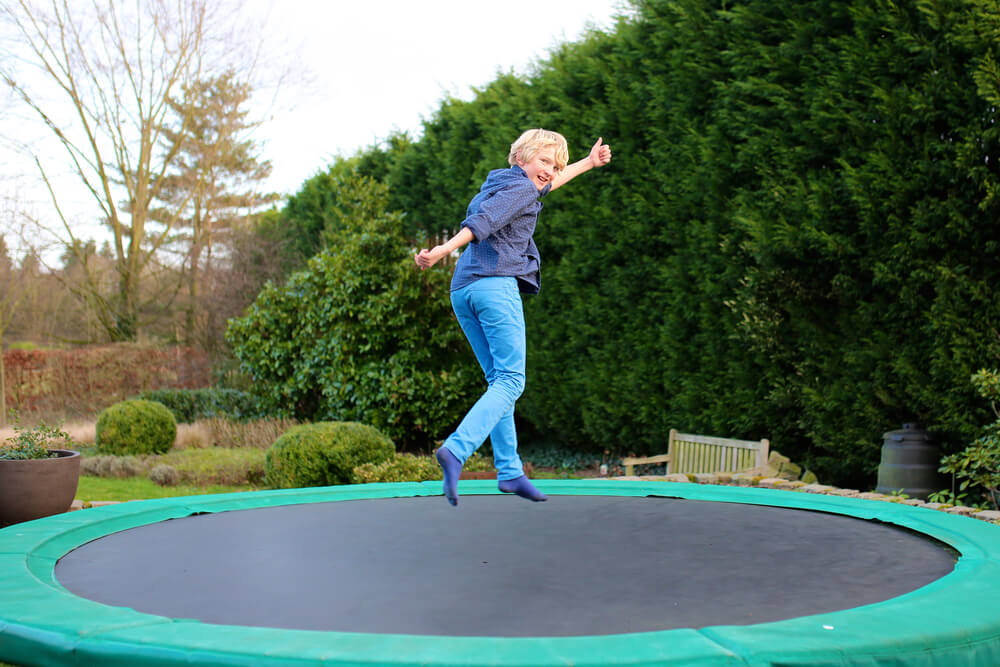Use these easy and inexpensive tricks to stop a trampoline from blowing away and save hundreds of dollars in trampoline replacement and thousands of dollars in damages it could cause to property.
When is it right to let the kids bounce on the trampoline?
On a sunny day? Not so bad as long as you’ve got a trampoline tent, jumping should go on.
On a rainy day? It could be fun but not advisable as it would make the mat slippery – a recipe for accidents.
How about when it’s windy? Wind can add more thrill to the bouncing, right?
But here’s the problem with that: it might blow away the trampoline, destroying it or even damaging other property near it.
That doesn’t mean no one should use a trampoline on a windy day, though.
You can use it, but you just need to know how to stop a trampoline from blowing away.
Read on to discover some fantastic tricks that’ll make your rebounder defy the strongest winds on any day.
1. Place the Trampoline in a Place Surrounded by Natural and Man-Made Barriers
A trampoline looks stunning on any part of the backyard, but you can’t just place it anywhere.
The easiest and most cost-effective way to prevent a trampoline from getting blown away is to ensure artificial, and natural barriers surround it.
Trees and hedges surrounding the garden are the best natural barriers to help stop the rebounder from moving away when a strong wind strikes.
Similarly, artificial barriers, such as walls and high fences, can help stop the trampoline from blowing away.
So, it’s essential to consider the trampoline’s location and ensure it’s flanked by solid barriers to minimize the risk of it blowing away.
A point to note: While placing the trampoline near barriers is helpful, ensure it’s not too close to trees, walls, or fences to minimize the severity of injuries if the jumper accidentally falls off the mat to the sides.
What if My Space is Devoid of Wind Barriers?
If your garden doesn’t have many wind barriers, chances are it might end up catching a gust of wind.
This situation may make you worried when the weather is stormy or on days when the wind is higher than usual.
If that happens to be the case, you can still secure the trampoline using other techniques.
And even if lots of barriers surround the trampoline, we still recommend that you tie it down for extra stability.
That said, here are other tried and tested ways to keep the trampoline secure:
2. Trampoline Anchors
Are you in an area where storms come unannounced?
Don’t let them destroy your precious investment before it serves you for years.
Here’s a great way to secure the trampoline and keep it from being blow away – anchors.
Anchors come in different types (more on that in a minute) and have diverse ways of tying them to the ground. So, your choice depends on the trampoline type, your location, and your personal preference.
Types of Trampoline Anchors
There are two main types of trampoline anchors: the U-shaped and Augers or corkscrew anchors.
We’ll look at each type briefly.
U-Shaped Trampoline Anchors
The name talks about its appearance. But who’s the U-shaped trampoline anchor perfect for?
Well, the anchors are ideal for those looking for a budget and standard option to tie their rebounders to the ground.
But don’t let their budget price fool you. The anchors are created from steel, making them a beast in the longevity department.
Installing them on a trampoline isn’t rocket science, though; just fit them around the unit’s main poles, ground them with a hammer, and that’s it.
Things We Like about U-Shaped Trampolines
- Installation is a piece of cake.
- They can dive deep into the ground, providing a reliable and robust anchorage.
- They can quickly push through tough ground
- It can be used on nearly any trampoline model
Our Concerns
U-shaped anchors can easily pull out when enough force is used, making them a not-so-good fit for areas with strong winds.
Augers or Corkscrew Anchors
Augers are among the best trampoline anchor kits, and for a good reason: they keep the trampoline firmly secured to the ground.
The reason why corkscrew anchors provide superior anchorage is their shape.
Screws hold two wooden pieces together better than a standard nail would, right?
Their threaded shape allows them to stay solidly in the ground compared to straight anchors or those without much thread.
Things We Like about Corkscrew Anchors
- They work well in places with strong winds and heavy rainfall
- The thread provides better grip in the ground
- They can’t easily come out even when you use the trampoline regularly.
Our Concerns
- A little pricier than the other types
- Installation requires some elbow grease
3. Wind Stakes
If you’re looking for an inexpensive and easy way to hold a trampoline down during a storm, you may want to consider wind stakes.
They come in “J” or “U” shapes for securing the trampoline on the ground. Typically, the stakes have a length of between 10 and 14 inches.
Installation is a walk in the park; you only need a hammer, and you’re all set. But after a strong wind, you may have to hammer them again.
Things We Like about Wind Stakes
- Affordable
- Easy to Install
- They’re low profile, which makes them safer, preventing tripping hazards.
Our Concerns
- The wind stakes don’t provide extra support to the trampoline
- If you use the trampoline frequently, wind stakes loosen up, becoming unreliable
- On wet or soft grounds, the stakes may become loose on a stormy day
Tips for Additional Stability and Safety When using Wind Stakes
For wind stakes to provide better stability, space them at an equal distance from each other – typically two inches apart, so they’re wide enough to grip most trampoline legs.
You can also pour concrete into the dug-in section around the stake. This is a lasting solution-you won’t keep on moving the stakes around.
What Are Some of the Best Trampoline Anchors and Wind Stakes on the Market?
After extensive research, we noticed these are the trampoline anchors and wind stakes users praise the most:
i.) SkyBound Heavy Duty Corkscrew Trampoline Anchor Kit
It comes with four corkscrew stakes measuring 15 inches long. The screw length provides excellent anchorage to the ground that secures the trampoline despite any force from strong winds. Additionally, this anchor is easy to install.
The augers are extra tough to stand against the elements, thanks to the black steel coating. It comes with 8ft long heavy-duty nylon tie-downs, giving you adequate length to anchor the rebounder securely.
ii.) JumpSport Trampoline Anchor Safety Set
Like the SkyBound, this one features four screws and four straps for securing the trampoline to the ground.
If you reside in areas frequented by hurricanes and tornadoes, you may consider this anchor set. It may just be what you need to save thousands of dollars in property damage or and more hundreds of dollars in trampoline replacement.
iii.) Skywalker Trampoline Wind Stakes
Not only are the wind stakes easy to install, but they’re made from weather-resistant galvanized steel, making them durable.
They also come with a universal size that fits any trampoline whose leg diameter is up to 2 inches.
Both stakes and anchors provide adequate protection in severe weather. What if you stay in an area prone to hurricanes or tornadoes?
That’s where the following recommendation comes into play.
4. Sandbagging
If you’re from an area where the wind or storm is too strong for anchor kits and wind stakes, it’s time to consider sandbags.
This method involves placing sandbags over the trampoline legs to secure it.
While this is a budget-friendly option, you can also find high-end sandbags with an expensive construction that functions much better than the standard ones.
The more sandbags you place on the trampoline’s leg structure, the more stable and secure the trampoline.
Looking for high-quality yet pocket-friendly sandbags to secure your trampoline to the ground? Here are some popular options:
i.) ZMAYI Heavy Duty Sandbag 4 pcs/Pack
Each of the four bags can accommodate sand of between 25 and 30 lbs. It’s suitable for trampolines whose leg size is 15mm to 50mm.
The bags feature double Velcro straps and a double stitch line instead of zippers. The Velcro seals are easy to use and won’t easily open.
The sandbags are made from heavy-duty polyester with a PVC coating, making them waterproof.
Once you feel the bags with gravel, sand, snow, or any other heavy material, you can bounce on the trampoline and not worry about it being blown away.
ii.) ABCCANOPY Gazebo tent Sandbags
If your trampoline legs have a diameter of between 15mm and 50mm, these bags will work.
The pack of four sandbags can hold between 20 and 25 pounds of rock, sand, or dirt.
They feature a waterproof 1680D polyester fabric with a PVC coating that’s 300% stronger than average bags on the market.
And did we mention these sandbags come in a variety of colors too? You can choose from black, blue, orange, white, yellow, or gray.
Final Word
Hopefully, now you know how to stop a trampoline from blowing away. All of the methods work, but your choice may depend on your location, frequency of trampoline use, budget, and personal taste.
Securing a trampoline to the ground is one of the ways to lengthen its lifespan and protect any nearby property from damage as well.


